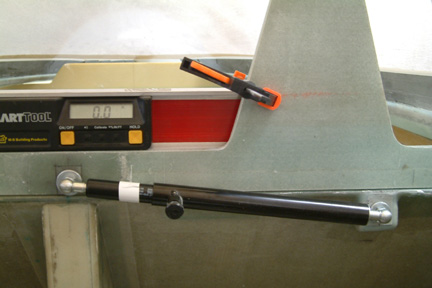Chapter
18 - Section 22
Canopy
Stop
The
mounting
location of the gas spring strut varies quite a bit among Cozy builders. The
plans' method is to mount the anchor end at the left side of the passenger headrest and the extended side to the canopy bulkhead. However, I haven't decided what headrest I was going to use, therefore
the plans' mounting location is somewhat out of the question. In addition, I do
not care for the gas strut position when the canopy is closed - it blocks the
through space between the front and back seats in flight. On the other hand, if
I do not follow the plans mounting method, I have to come up with a new set of
geometry and mounting locations. I decided to search through the Cozy forum and
builders' web pages to educate myself on the subject.
Both
John Basol and Clark Canedy have a nice mounting scheme that does not involve the
head rest. Al Wicks describes his
in the Cozy forum (similar to Canedy's approach) but no pictures. One of the highly recommended features is
a lock on the gas strut when it is fully extended. Evidently, if the
wind catches the canopy just right when it is at its open position, it could
slam down on your head and ruin your whole day. The extension lock is to prevent
that from occurring.
|
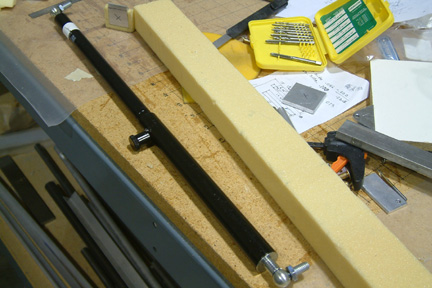 Due
to the variations in mounting methods among Cozy builders, there are many gas
struts recommended. The bottom line is, it really depends how you plan to mount
it. The deciding factors are its overall length, its stroke and its force. I
found mine from McMaster-Carr (P/N 9425k14) that is 19.72" overall length and
7.87" stroke. Note the auto extension stop (button) at the middle of the
strut?
Pulling the button will release the strut for collapsing/closing the canopy. The nice thing about this strut is that it comes in different
forces (15 to 120 lbs) - all in the same dimensional configuration. In other words, I can change
the force of the strut without changing its mounting locations and methods -
just in case. I bought a 50 lb force first, but felt it was too stiff. So I
exchanged it for a 30 lb for initial mounting. I'll finalize the force after I
complete the mounting. Due
to the variations in mounting methods among Cozy builders, there are many gas
struts recommended. The bottom line is, it really depends how you plan to mount
it. The deciding factors are its overall length, its stroke and its force. I
found mine from McMaster-Carr (P/N 9425k14) that is 19.72" overall length and
7.87" stroke. Note the auto extension stop (button) at the middle of the
strut?
Pulling the button will release the strut for collapsing/closing the canopy. The nice thing about this strut is that it comes in different
forces (15 to 120 lbs) - all in the same dimensional configuration. In other words, I can change
the force of the strut without changing its mounting locations and methods -
just in case. I bought a 50 lb force first, but felt it was too stiff. So I
exchanged it for a 30 lb for initial mounting. I'll finalize the force after I
complete the mounting.
With
the strut in hand (30 lb), I mimicked both John Basol's and Clark Canedy's mounting methods
(using clamps and temporary fixtures). The
following result is based on MY temporary mounting method and MY selection of
strut, your mileage may differ. I
recommend you contact them for more informed directions, because both of them
are VERY
gracious and helpful to Cozy builders and I want to thank them for their
support! Both mounting methods work well.
With Basol's approach, my gas strut effectiveness starts a bit sooner (~41o,
and I expect it to be even sooner with a higher strut force) than with Canedy's
approach (~44o). Actually I was really surprised by the small
difference. On the
other hand, Canedy's approach has the strut standing vertically behind the
passenger's headrest when the canopy is fully opened. Conversely, with Basol's
approach, my strut will be positioned at an angle stretching from the center of the seatback
to the canopy bulkhead. Its a tough call because I liked the early effective
support. After some pondering, I decided to go with less blockage space per Canedy's
approach, trading off with higher effective angle (height) - its just a personal
preference.
|
[Hindsight]
A seasoned Cozy flyer once told me that his canopy opened in flight -
it has got to be one frightening experience! Here's what I learned...The instant
the canopy flips open in flight, a 160 mph gust of wind will smack you head on.
Your hat, glasses, head set, pencils, maps, knee board will depart without any
hesitation. The force of wind will stretch your facial skin backwards, keeping
your eyes shut but a big smile (though it won't be amusing to you at this
point). You'll loose all communication with the Tower and you have to duck low
to look forward (while avoiding the head wind). Now, your death grip is on the
control stick and you'll be screaming to yourself "fly the plane". Fortunately you are still
strapped into your seat...
Gaining your composure, you want to close the
canopy...but the gas strut has a button lock. Now you realize it is impossible
to release the lock and at the same time pull the canopy back down with just a
single hand (assuming my type of lock strut and you have to fly the plane with the other hand). The extra pull rope is waving in the wind and cannot be reached.
The Cozy flyer was cool headed and returned safely. I am not sure I could do the
same, hmmmm.... A lock on the gas strut may not be such a good idea after all... Well,
I can certainly switch to a non-lock gas strut - same configuration from
McMaster (4138T575) for $14.47.
Now I have an interchangeable set up for lock and no-lock
gas strut to support my canopy. However, neither one solves the lock coming loose
in flight problem. As a matter of fact, both struts help to push the canopy open,
once the lock is released
 . I need to figure out a better solution....
. I need to figure out a better solution....
Enter dual actuator control side canopy - continued in
Ch18_22A
 .
.
 Due
to the variations in mounting methods among Cozy builders, there are many gas
struts recommended. The bottom line is, it really depends how you plan to mount
it. The deciding factors are its overall length, its stroke and its force. I
found mine from McMaster-Carr (P/N 9425k14) that is 19.72" overall length and
7.87" stroke. Note the auto extension stop (button) at the middle of the
strut?
Pulling the button will release the strut for collapsing/closing the canopy. The nice thing about this strut is that it comes in different
forces (15 to 120 lbs) - all in the same dimensional configuration. In other words, I can change
the force of the strut without changing its mounting locations and methods -
just in case. I bought a 50 lb force first, but felt it was too stiff. So I
exchanged it for a 30 lb for initial mounting. I'll finalize the force after I
complete the mounting.
Due
to the variations in mounting methods among Cozy builders, there are many gas
struts recommended. The bottom line is, it really depends how you plan to mount
it. The deciding factors are its overall length, its stroke and its force. I
found mine from McMaster-Carr (P/N 9425k14) that is 19.72" overall length and
7.87" stroke. Note the auto extension stop (button) at the middle of the
strut?
Pulling the button will release the strut for collapsing/closing the canopy. The nice thing about this strut is that it comes in different
forces (15 to 120 lbs) - all in the same dimensional configuration. In other words, I can change
the force of the strut without changing its mounting locations and methods -
just in case. I bought a 50 lb force first, but felt it was too stiff. So I
exchanged it for a 30 lb for initial mounting. I'll finalize the force after I
complete the mounting.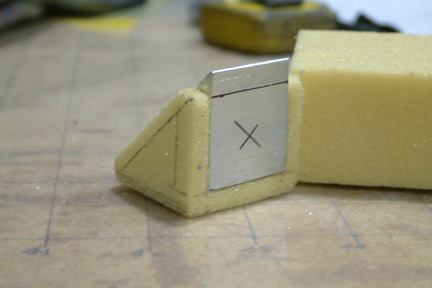 The
aft face of my canopy bulkhead lines up almost flush to the back edge of the seatback. There
is no room to mount an anchoring block (hard point) for the gas strut per Canedy's mounting
method. I also prefer not to have the strut taking up space in front of the
canopy bulkhead (& on top of the seat back), which is reserved for the
headrest and whatever electronics goes there. Therefore, the only logical space I have
is at the back edge of the seatback (passenger side).
The
aft face of my canopy bulkhead lines up almost flush to the back edge of the seatback. There
is no room to mount an anchoring block (hard point) for the gas strut per Canedy's mounting
method. I also prefer not to have the strut taking up space in front of the
canopy bulkhead (& on top of the seat back), which is reserved for the
headrest and whatever electronics goes there. Therefore, the only logical space I have
is at the back edge of the seatback (passenger side).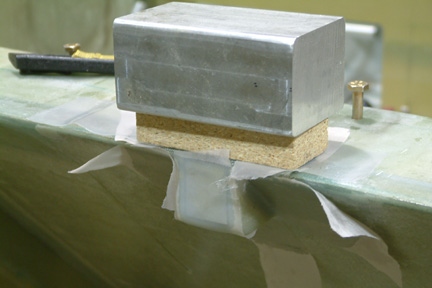 I
mixed some wet flox with 5-min. epoxy and held the foam/hard point block against
the seat back until the 5-min epoxy cured. Then I packed flox around all sides
of the hard point. I wrapped the entire mounting anchor with 2 layers of
BID. Note that I wrapped some of the BID over to the top
of the seat back - the wood block and weight were there to hold the BID down
during cure. Then I peel-plied and allowed it to cure.
I
mixed some wet flox with 5-min. epoxy and held the foam/hard point block against
the seat back until the 5-min epoxy cured. Then I packed flox around all sides
of the hard point. I wrapped the entire mounting anchor with 2 layers of
BID. Note that I wrapped some of the BID over to the top
of the seat back - the wood block and weight were there to hold the BID down
during cure. Then I peel-plied and allowed it to cure. 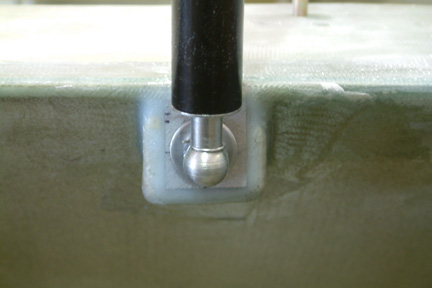 After
the BID cured, I re-marked the center of the hard point, and drilled and tapped for
5/16-18 threaded hole for the anchor end of the gas strut. I also added a flat
washer to spread out the compression force.
After
the BID cured, I re-marked the center of the hard point, and drilled and tapped for
5/16-18 threaded hole for the anchor end of the gas strut. I also added a flat
washer to spread out the compression force. 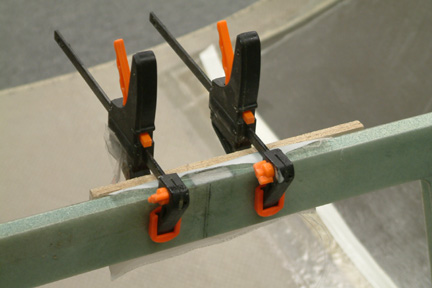 The
mounting hard point for the extended end is a bit thicker than the anchor hard
point because the canopy bulkhead (foam) is 3/8" thick. I cut up a 1x1x3/8 aluminum
square for the purpose. I then pre-marked (above) and cut out a 1"x1" slot
(including the aft BID layers) at the mounting location on the canopy bulkhead. I
added wet flox and embedded the hard point in place. Then I laid up 1.75" x
4" BID (6 layers) and UNI (2 layers) over the hard point and along the
canopy bulkhead. I peel-plied and clamped down for
cure. You can see the hard point embedded in the foam.
The
mounting hard point for the extended end is a bit thicker than the anchor hard
point because the canopy bulkhead (foam) is 3/8" thick. I cut up a 1x1x3/8 aluminum
square for the purpose. I then pre-marked (above) and cut out a 1"x1" slot
(including the aft BID layers) at the mounting location on the canopy bulkhead. I
added wet flox and embedded the hard point in place. Then I laid up 1.75" x
4" BID (6 layers) and UNI (2 layers) over the hard point and along the
canopy bulkhead. I peel-plied and clamped down for
cure. You can see the hard point embedded in the foam. 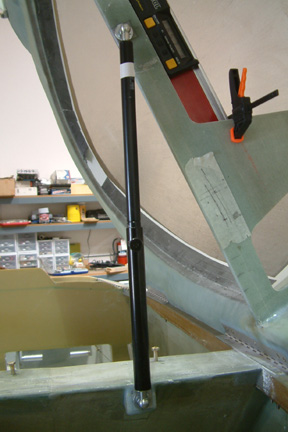
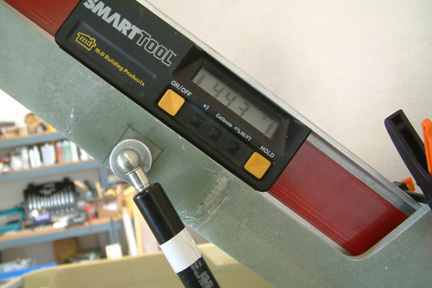 The
effective support angle (by the gas strut) starts at 44.3o. In other
words, the gas strut takes over when the canopy is opened to 44.3o. Bare
in mind that I am using a 30 lb force strut for this measurement. If I used a higher
strut force (i.e. 40, 50 lbs etc.), I believe the effective support angle will be
lower. However, there will be more stress against the hard points when the strut
is compressed (i.e. canopy in closed position as shown below). I felt the 30 lb was
quite adequate for my installation and will leave it as is for now...
The
effective support angle (by the gas strut) starts at 44.3o. In other
words, the gas strut takes over when the canopy is opened to 44.3o. Bare
in mind that I am using a 30 lb force strut for this measurement. If I used a higher
strut force (i.e. 40, 50 lbs etc.), I believe the effective support angle will be
lower. However, there will be more stress against the hard points when the strut
is compressed (i.e. canopy in closed position as shown below). I felt the 30 lb was
quite adequate for my installation and will leave it as is for now...
